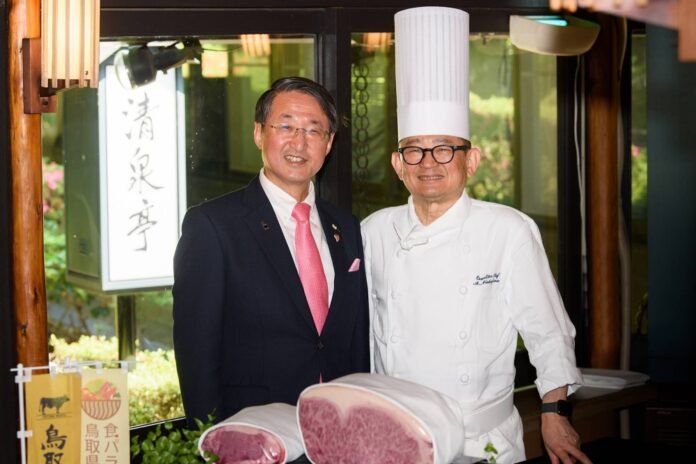The Tottori Wagyu Fair will take place in six restaurants at Hotel New Otani Tokyo until July 15. The event has been organized by the hotel every year since 2018 and this year offers a new way to enjoy the premium Wagyu together with wine from Tottori Prefecture.
In a recent interview that took place in Seisen-tei, a Teppanyaki grill restaurant located in the Japanese garden of the hotel, Tottori Gov. Shinji Hirai and Shinsuke Nakajima, the executive director and chef of New Otani Co. Ltd., talked about the high-quality Wagyu and its combination with wine produced by Hojyo Winery in Tottori.
In Tottori, which has a centuries-old tradition as one of Japan’s most important horse and cattle markets, there are descendants of the Ketaka bull that won first prize at the first Wagyu competition in the 1960s. “Descendants of the Ketaka are characterized by the high content of oleic acid in the loin, the main component of olive oil. Unlike lard, fat containing a lot of oleic acid is not sticky. It is light and melts in your mouth easily,” Hirai said. This beautiful taste and texture has been inherited by many descendants of the Ketaka in Tottori.
Hirai said local farms have never stopped producing better, high-quality Wagyu despite many hardships in recent years, such as the rising cost of feed and utilities. “Against this backdrop, we are greatly encouraged by Hotel New Otani Tokyo’s commitment to promoting Tottori Wagyu and serving it with refined techniques,” he said.
He also raved about the successful combination of Tottori Wagyu and the local wine. “This wine is also the result of the continuous efforts of the producer, who overcame a huge wine loss of 50,000 bottles due to an earthquake in the central prefecture of Tottori in 2016. The winery’s third-generation manager and his Ukrainian wife have heart and mind poured into making good wines. We are proud and grateful that Hojyo wine has been chosen as part of the fair,” said Hirai.
Nakajima said chef sommelier Nobuhide Tani recommended the wine while creating the menus for this year’s fair. “The moment I tasted it, I was sure it matched perfectly with Tottori Wagyu. In the culinary world we often combine different ingredients produced in the same region for a harmonious effect. In the same way, I think the wine and beef made in the same area with the same clean water from the rich natural environment should be an ideal match,” said Nakajima.
You can taste the combination of the delicate and refined wine and the tasty and tender Tottori Wagyu at Sekishin-tei, a teppanyaki restaurant next to Seisen-tei overlooking a carp-filled pond and the Japanese garden. The wine can be ordered by the bottle or by the glass and is best enjoyed with meals of sirloin steak and beef fillet, along with rice and other Japanese-style side dishes.
“Tasting and comparing different cuts of meat, such as sirloin and fillet, is something we often do as chefs to assess the quality of the meat when deciding what and how to serve our guests. Offering our guests the opportunity to eat the meat in the same way as chefs in the kitchen is a testament to our trust in Tottori Wagyu,” said Nakajima.
This year’s Tottori Wagyu Fair menus include both new items and standards that have proven popular at the previous fairs. One of the perennials is a round steak, topped with lemon slices and lemon sauce, served at Satsuki coffee bar. “The high-oleic fat goes well with the freshness of lemon,” Nakajima said.
One of the new offerings is a smashed hamburger with sautéed mushrooms and onions, red wine sauce and cheddar cheese. “We thought the easiest way to showcase the unique characteristic of beef would be to create something that many people are used to eating,” Nakajima said.
Hirai noted that Tottori is also blessed with an abundant variety of livestock and crops, nourished by the rich nature and soil. “Tottori, for example, is an important production area for spring onions, watermelons, Nashi pears and Hakushu Bijin, a type of leek that becomes melty and sweet when simmered – another ingredient that goes perfectly with Tottori Wagyu,” he said. The prefecture also has many sights not to be missed, such as the vast sand dunes of Tottori; Mount Daisen, the highest peak in the Chugoku region; and the vast Sea of Japan. “By encountering Tottori’s delicacies at Hotel New Otani Tokyo, we hope that many people will be inspired to visit our prefecture and experience the environment and tradition that have nurtured its rich food culture,” Hirai said.
Tani explained that the reason why this wine is not labeled as vintage is that it is a blend of several great vintages from recent years. “As a result, the concentration and maturation unique to a great vintage is achieved, making this wine exceptionally balanced,” he said.



